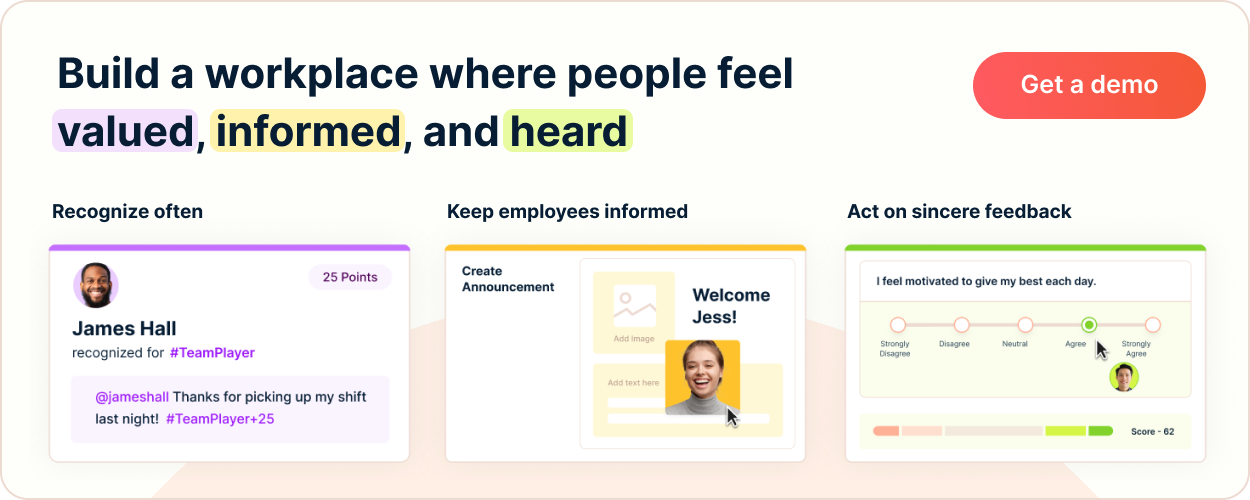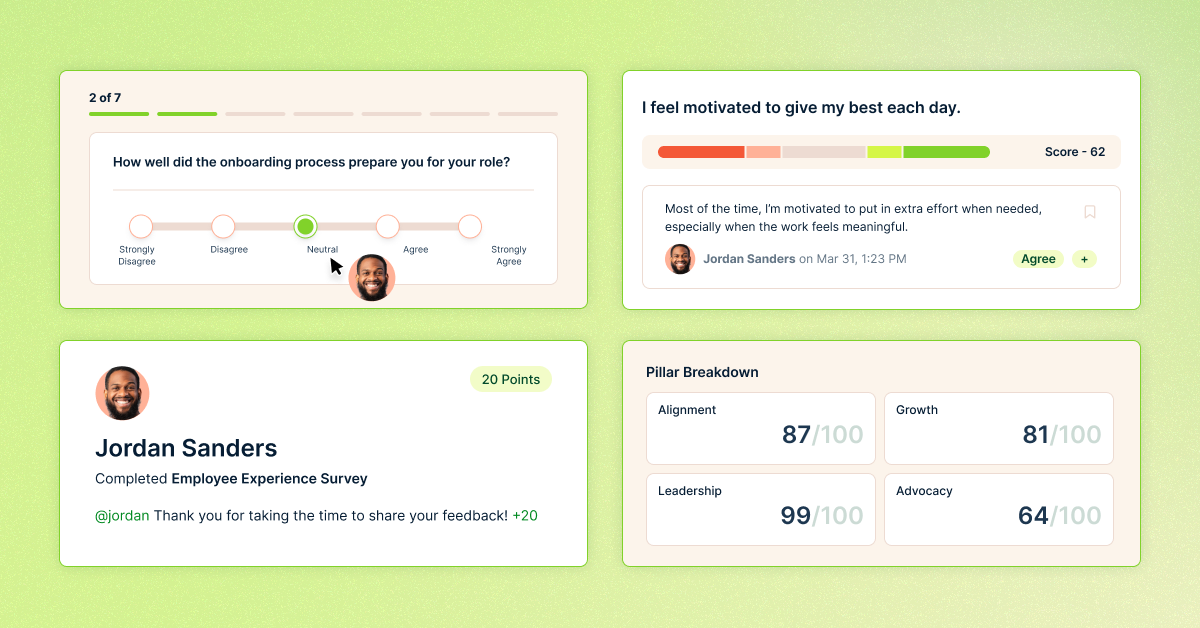Not Loyal, Not Lost: Rethinking Retention For The Employees In Between

Every leader knows who their standout employees are. The ones who consistently deliver great work, offer help without being asked, and genuinely care about the team’s success. They also assume they know who’s checked out, the employees who are disengaged, or eyeing the door.
But what about the employees in the middle?
We refer to these employees as the wavering middle. Workers who fulfill their roles reliably but haven't fully bought in or burned out. They're not problem cases, but they're not pillars either. This group sits in the murky middle zone: present and productive but poised to leave if the right (or wrong) conditions arise.
They represent the biggest retention opportunity and risk inside your organization. Wavering employees make up nearly half of today’s workforce, and over 60% say they’d consider their options when faced with common workplace scenarios. The truth is, work is hard right now. Post-pandemic shifts in what’s important, layoffs making headlines every week, and confusion about in-office versus remote work have created significant uncertainty for employees right now.
To better understand the wavering middle, we asked 1,000 employees how they would respond to ten common workplace challenges. For each scenario, respondents could select 'stay put,' 'start considering my options,' 'actively prepare to leave,' or 'not sure.' Their answers generated a flight risk score ranging from 0 to 20. A score of zero was the best possible score, while a score of twenty meant that employees were at serious risk of turnover.
Employees who scored between 7.00 and 12.22 became our focus. This group made up 46.1% of our respondents.
What would you do if you had just twenty more engaged employees? What leadership actions could they take over? What employees could they mentor? Companies and leaders that cater to this group and push more wavering employees to the low-risk category create a better workforce for everyone. This article explores best practices and an action plan to help you create a more engaged workforce by understanding the wavering middle.
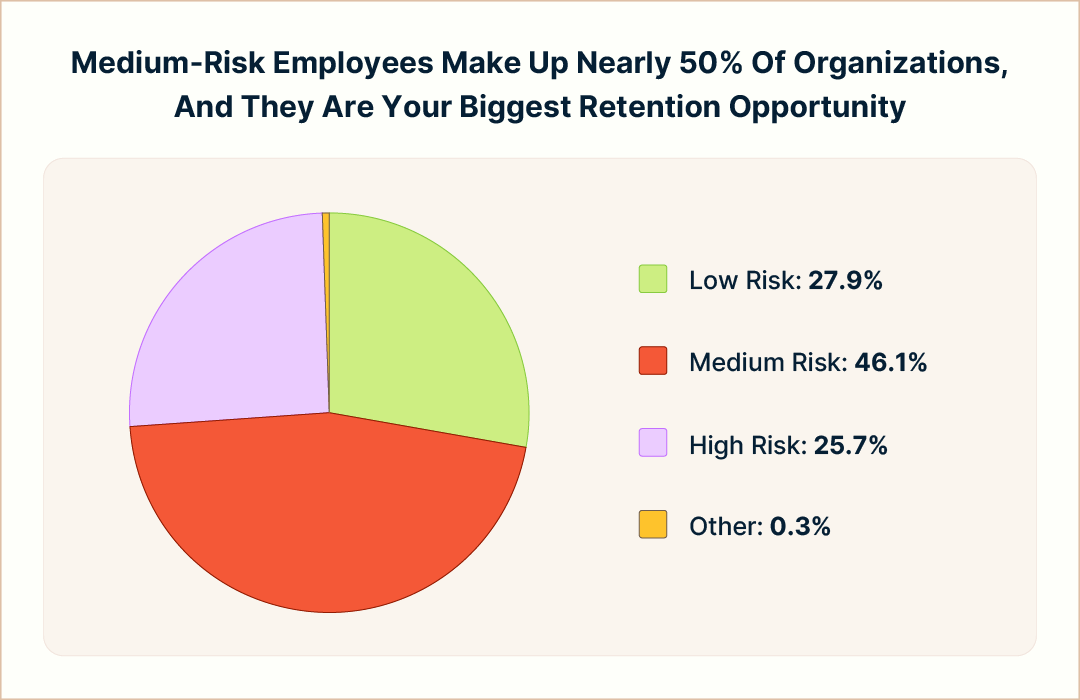
Are you ready to show loyalty to your team members? Download Nectar's latest eBook: "The Loyalty Blueprint," to understand how companies can show loyalty to modern employees.
The Wavering Middle: How Do These Employees Compare?
Think about your average work week. How much time are you devoting to your low and high-risk performers? HR teams tend to spend the majority of their time addressing issues and solving problems surfaced by the most dissatisfied and disengaged employees or trying to appease top performers.
In the book “On Fire At Work,” author Eric Chester refers to this as the 10-80-10 management mindset. Under this management practice, leaders spend 80% of their time dealing with 20% of their workforce. The top 10% and bottom 10% of a company get a lot of attention. This strategy leaves the wavering middle without much support, attention, or resources.
On the surface, employees in the wavering middle don’t set off alarms. They’re not submitting their two-week notice, they’re not vocally complaining about office policies or decisions, but they’re also not thriving. The wavering middle falls in the middle on several key work-life aspects. That quiet in-between is what makes them easy to overlook and hard to retain, especially when companies are undergoing periods of change or growth.

The 5 Scenarios Most Likely To Trigger Turnover In The Wavering Middle
We asked 1,000 employees how they would respond to ten common workplace challenges. These scenarios reflected real-life situations that could influence an employee's decision to stay, start looking for a new opportunity, or prepare to leave. The full list of scenarios we tested includes:
- A competitor offers 20% higher salary
- Your favorite coworkers all quit within a month
- Your company makes significant changes to your current work arrangement
- Workload increases significantly without added compensation
- A larger corporation acquires your employer
- Leadership actions no longer align with company values
- Your employer reduces employee benefits
- Your direct manager leaves the organization
- Career advancement opportunities at your company become limited
- Recognition programs undergo significant reductions
The wavering middle craves stability, fairness, and alignment. It's not just about money or policy shifts. It's about broken signals: leadership isn’t backing up its values, recognition isn’t matching effort, and work isn’t sustainable.
The scenarios most likely to shake the wavering middle are often the ones companies downplay or handle reactively. A simple lack of intention, consideration, or foresight can have enormous implications for nearly half of your workforce.
For example, 93.7% of wavering middle employees are at risk after a benefits reduction. Sometimes, companies need to make these changes in response to changing medical costs. Leaders could save more employees by increasing communication around these changes. For example, you could give employees a glimpse of your benefits process.
- What meetings did you hold with insurance providers?
- What quotes did you receive?
- Why did you ultimately pick the plans you did?
- How can they make the most of the insurance plans you do have?
Working closely with your insurance provider to be transparent about your benefits process will put many minds at ease. It’s a sign that you are asking the right questions and thinking of your people.
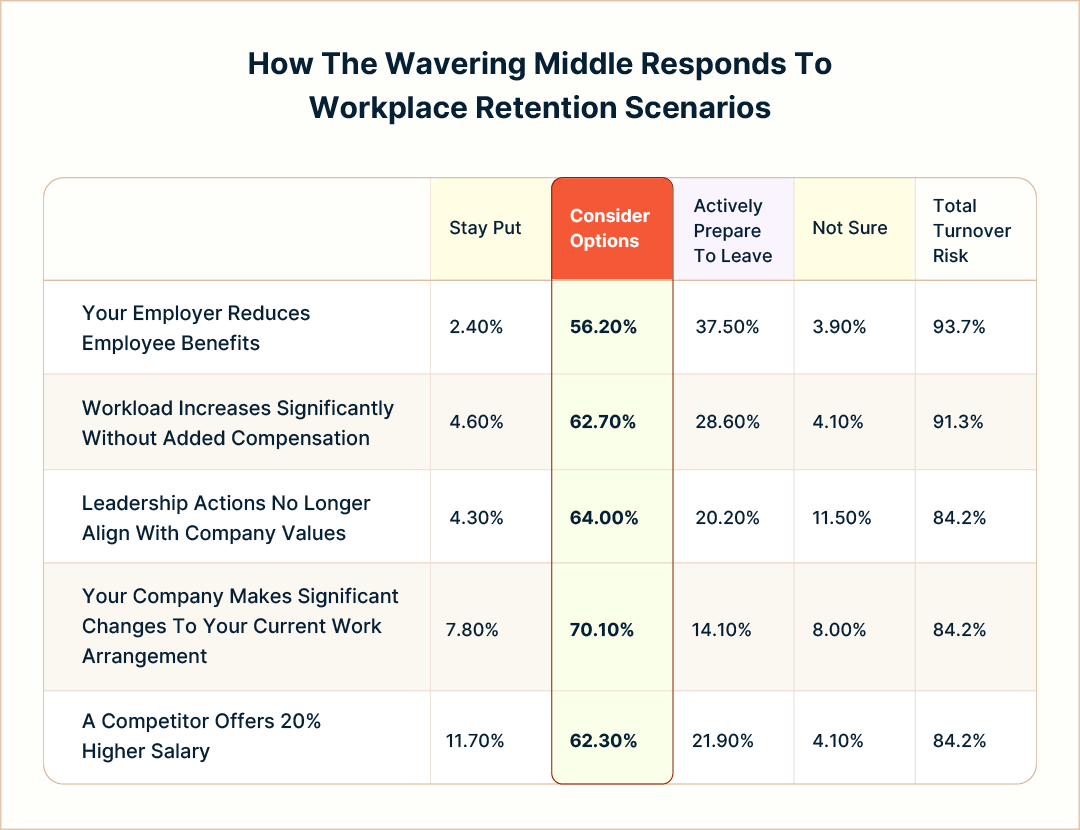
Why The Wavering Middle Is A Retention Goldmine
Have you ever been blindsided by an employee's unexpected departure? When you lose a wavering employee, your first thought might not be the impact they will make on your workflows. They aren't a top performer, after all. You might not sigh with relief like you might when you lose a disengaged employee. These employees aren't a focus, so when they leave, you feel unsure. They were fine a week ago, right?
Wavering employees don't make waves until they give their two-week notice; their power comes in numbers. Losing these team members creates a domino effect, with other wavering employees and top team members also being affected.
Most retention strategies focus on the extremes: elevating top performers and rescuing the disengaged. That seems logical, but it overlooks the group quietly holding everything together.
Wavering employees aren't underperforming. They're experienced, steady, and deeply embedded in your systems. Many have stepped up without fanfare, taking on challenging roles, filling gaps, and supporting peers without ever seeking recognition or a new title.
This doesn't mean you should ignore your top talent. Supporting the middle helps protect your best people. When the quiet backbone of your organization gets stronger, your stars don't have to carry the entire load.
These employees aren't lost, but they're also not loyal. In most scenarios, they're not actively preparing to leave. They're just looking for signs it's worth staying. If you catch them now, you're reinforcing the entire foundation of your team.
5 Tips For Engaging Medium-Risk Employees (At Scale)
Now that you have the facts on wavering employees, how do you engage them at scale? Recognition, creating nonlinear growth paths, and utilizing employee-to-employee connections are some of the best places to start. Engaging these team members is easy once you have the proper infrastructure in place.
1. Make Recognition Purposeful And Peer-Driven
Recognition is an often overlooked lever for bringing wavering employees into the fold. Imagine wrapping up an exhausting work week where you felt ignored at work. You completed several tasks and assisted some colleagues with significant requests. Before you close your computer on Friday, imagine getting a message from a colleague with genuine praise for how you helped them at work. Frequent and meaningful recognition is a culture quencher that makes employees feel seen when they need it most.
Recognition is also something that can be easily scaled. With a well-defined employee recognition policy and program, everyone in your organization can be involved, from leaders to peers to customers.
We spoke with Brittany L. Truszkowski, the Chief Operating Officer at Grand Canyon Law Group, and she shared the following about wavering employees:
“They want to feel seen and useful. They’re often steady, reliable people who aren’t chasing promotions every quarter, but they light up when they know their work matters. Recognition tied to purpose—like calling out how their consistency helped the team hit a goal—goes further than a generic ‘great job.’”
To scale your recognition program:
- Train managers and executives to give purpose-aligned recognition. Encourage leaders to go beyond a good job and provide recognition that's authentic and timely.
- For example, after an employee completes a big client project, a leader could say, “I was seriously proud of how {Name} led the client project. The client had great feedback, and it reminded me how lucky we are to have someone so dependable and thoughtful on the team.”
- Utilize peer-to-peer platforms to integrate appreciation into your team's culture.
- Survey your employees to understand what type of recognition means the most to them.
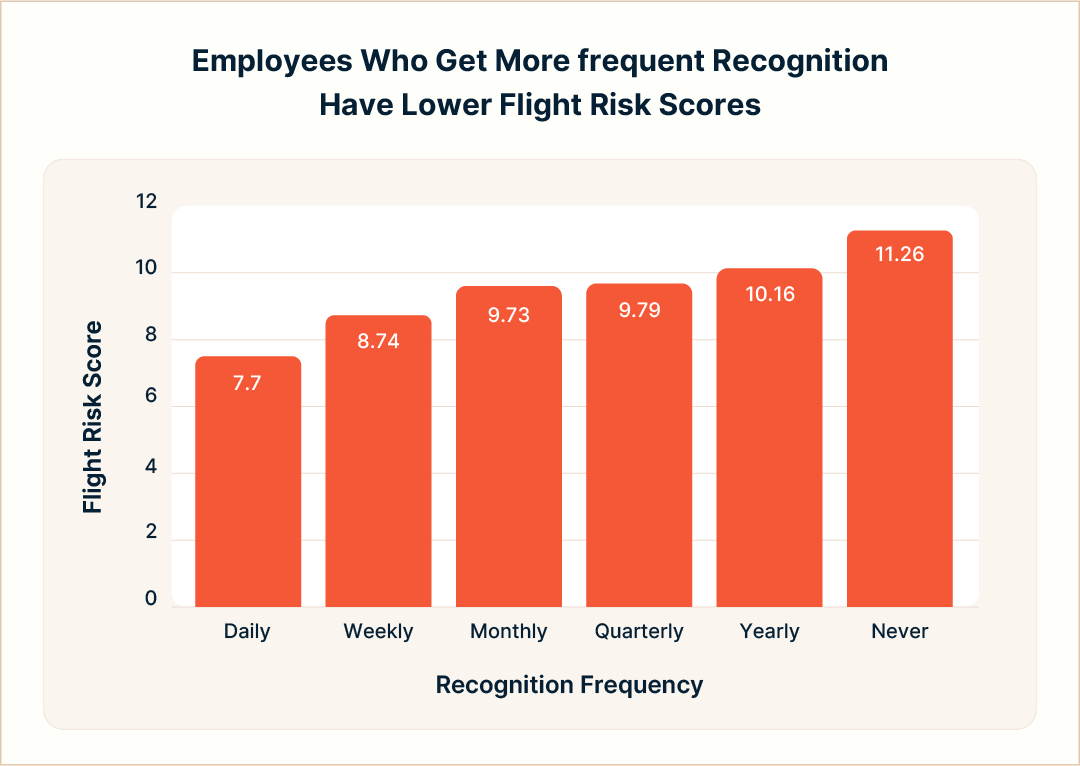
Nectar Tip: Highlight The Small, Everyday Wins
Every significant thing your team accomplishes is the culmination of several smaller wins. How does a top salesperson close a big deal? It's the consistency in follow-up, maintaining a clean pipeline, and adhering to best practices that gets them there. Without the tiny steps, the big steps would never happen.
The best leaders know that employees need consistent motivation along the way, not one pat on the back once a big project is over the finish line. Some of your wavering employees may not have the patience to see a project through to its completion. Help them break down a big task into smaller milestones, and give plenty of praise along the way.
2. Create Nonlinear Growth Paths With Meaningful Ownership
For many employees, being a great individual contributor is their career path; however, many companies focus on leadership as a path to increased pay and recognition at work. Instead of assuming that your wavering employees want a leadership position, offer opportunities to grow in their careers without forcing a title change.
- Let employees lead onboarding, pilots, committees, or peer mentorship.
- Co-create stretch goals in low-stakes check-ins.
- Spotlight impact and initiative, not just hierarchy.
- Create promotion tracks for individual contributors.
Employees stay when their work feels meaningful, and their growth feels real, even without a new title. Brittany L. Truszkowski, Chief Operating Officer at Grand Canyon Law Group, shared another useful story on nonlinear growth paths with us:
“We had a paralegal who checked all the boxes for a future leadership role.
But as we began giving her leadership-oriented responsibilities—running meetings, managing performance conversations—something felt off. Her confidence wavered, her energy dipped, and the enthusiasm we’d always seen in her started to fade.
So we pivoted. Instead of pushing her into a formal leadership track, we created a peer training role where she helped onboard new hires and ran micro-trainings on firm processes. That one change lit her up. She’s now one of the most trusted internal trainers we have, and her influence has grown far beyond what a title ever could have given her.”
Nectar Tip: Avoid Silent Promotions
One in three wavering employees has taken on increased responsibilities without a title change. This type of silent promotion is prevalent across our risk groups, but is most present for wavering employees.
You can assign employees additional responsibilities without falling into the trap of a silent promotion, but it requires intention. Set clear expectations upfront and ensure employee workload remains manageable. If you're asking someone to take on something like leading a committee, consider what you can offer in return. That might mean removing another task from their plate, providing a modest pay increase, or giving them dedicated time for the new responsibility. The key is to balance the ask with visible support and acknowledgment.
3. Reaffirm Loyalty Through Everyday Actions
Loyalty is not a one-way street. Wavering employees value reciprocity at work, and they want companies to take the lead. They want to feel loyalty coming from leaders and managers.
Company loyalty is about authenticity. Employees know that you will not stick with them through thick and thin. Economic downturns occur, and companies adjust their strategies. Employees understand that tough decisions need to be made for the greater good of the company. But what are you doing to show your team that you are doing the best you can to support them every day?
Employees who believe their company is highly loyal are 4.8 times more likely to report being highly loyal themselves compared to those who perceive their company as disloyal.
Showing your loyalty can take many forms, including:
- Paying employees a decent wage that keeps up with inflation
- Recognizing employees for their hard work with authentic shoutouts and praise
- Thinking of ways to provide job stability and security, even in economic downturns
- Backing up your team when issues arise with vendors and customers
- Acting on employee feedback when it comes to the attention of leadership
4. Build Belonging By Engaging Culture Champions
The wavering middle makes up about 50% of your workforce. It doesn’t matter if you have 50 employees or 5,000; the process of engaging the wavering middle requires more than a handful of people. If your only levers are your HR team and managers, you'll be outnumbered. You need a solid group of culture champions who can help you scale these one-on-one conversations and interventions.
A culture champion is an employee who consistently embodies your company's values and helps set the tone for others. They don't need a formal leadership title—their influence stems from how they present themselves and support the team. You can shape the role to fit your needs, whether it's an informal recognition or a formal program. For example, some organizations establish a culture champion committee that meets regularly to brainstorm ways to strengthen the culture and foster connections across teams.
Where Do You Find Culture Champions?
You don’t need to look far or high on the org chart. Champions often include:
- Steady performers who quietly show up for others (even without a title)
- Respected peers who model values and influence team energy
- Past wavering employees who found renewed motivation through involvement
- Non-managers who lead with consistency, not ambition
These types of employees are already helping shape the day-to-day tone. They're trusted across the organization. You just need to give them a bigger role, along with clarity and support.
What Can Culture Champions Do?
Champions aren’t just culture cheerleaders; they’re connectors. To make this role actionable and non-performative, culture champions can:
- Host micro-events, such as 15-minute coffee chats and onboarding buddy systems.
- Highlight peer wins through your employee recognition platform, company newsletters, and meetings.
- Bridge the silence that happens in your organization. When someone seems checked out, they can ask, "Are you doing okay?" before a manager even notices.
- Create belonging by helping new or wavering employees find a friend, a rhythm, and a reason to show up with more heart.
5. Reinforce Stability and Security Before It's Needed
The wavering middle craves stability. Layoffs and force reductions have made it challenging for employees to feel comfortable at work. Wavering employees are particularly susceptible to change. Even simple changes, like a larger corporation acquiring their employer, led 44.90% of wavering employees to start considering their options.
The wavering middle watches how companies handle change. Uncertainty breeds flight risk. Proactive stability builds trust.
- Share context early during organizational changes or leadership transitions
- Celebrate internal mobility and “quiet” retention wins
- Normalize stay interviews and career check-ins, not just exit interviews
Employees don’t need promises. They need proof you’re planning to keep them and upskill them so they become more valuable team members. Stability speaks louder than strategy.
Catherine Howland, Internal Communications Strategist and Principal at Human Doings/Human Beings, shared the following insights:
“ERG Theory is a way to understand workplace needs based on three core areas: Existence (pay and stability), Relatedness (trust and connection), and Growth (meaning and learning). Alderfer, who developed this framework inspired by Maslow’s hierarchy of needs, said that when people stop feeling connected or valued, they naturally shift their energy toward protecting what they do have. When our needs aren’t being met, we tend to prioritize safety over creativity and pull back from projects that once lit us up.”
Safety is paramount to everything we want employees to be. You can't get innovative and scrappy employees if your team feels unsafe.
Your Action Plan For Motivating The Middle
Addressing the middle requires a layered approach from HR teams. There are a few quick things you can do to move the needle, but systemic changes are needed to move wavering employees into a more engaged state.
Create an action plan to tackle this group. Pick 5-7 ideas you can implement across the next six months based on these ideas. For example, choose three quick wins, two medium-term initiatives, and one long-term solution. By the end of your six months working on this group, you should see a positive impact on your team's engagement.
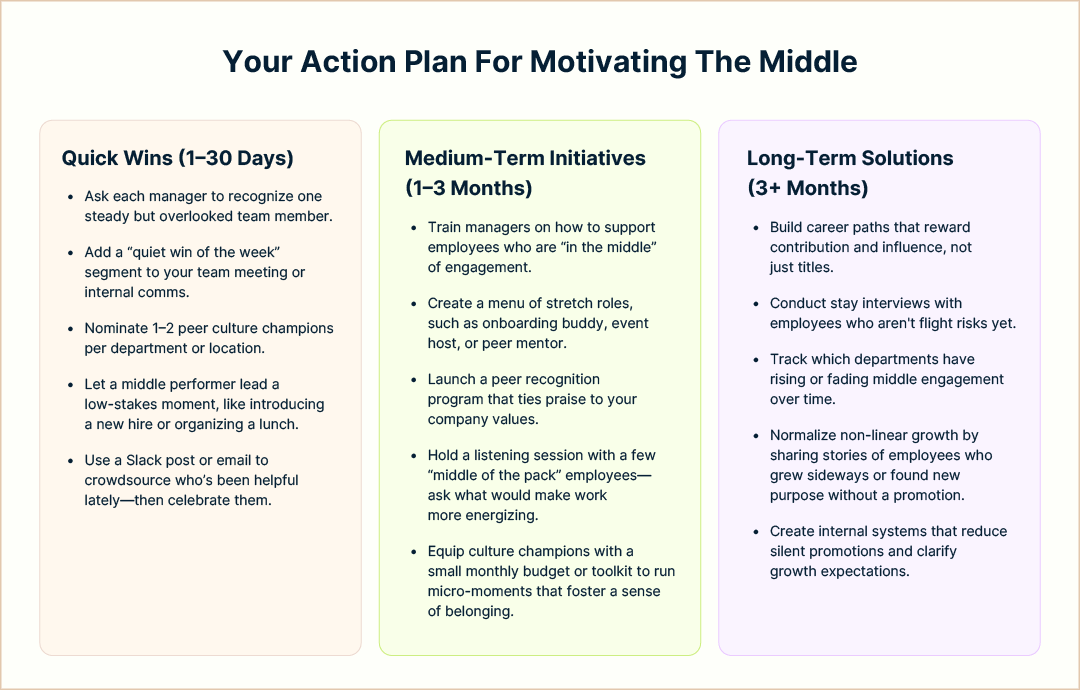
How To Know Engaging The Middle Is Working: Loyalty Signals To Watch For
Once you've launched your initiatives, keep a close eye on the quiet signs of progress. Loyalty from the middle is often
quiet at first as employees build trust in their leadership. That's why tracking a handful of subtle but strategic loyalty signals is important. These signals will help you understand whether your action plan is gaining traction.
Consider using a lightweight dashboard or checklist to review progress in these areas regularly.
- More voices in the room: Employees who previously stayed quiet start speaking up, commenting in chats, contributing ideas, or asking thoughtful questions in meetings.
- Recognition becomes more active and peer-driven: The team starts using recognition tools more organically. You may notice an increase in shoutouts, Slack praise, or challenge participation—especially from employees who were previously uninvolved.
- Employees initiate growth conversations: Instead of waiting to be asked, middle performers express curiosity about career development, take on stretch projects, or explore new internal roles.
- Silo walls start to come down: Watch for increased collaboration between departments or teammates who didn’t previously connect. This could show up in joint Slack threads, shared docs, or multi-team initiatives.
- Exit signals become less common: Exit interviews mention burnout or stagnation less often. Fewer employees casually mention “exploring options” during one-on-ones.
- Pulse survey sentiment improves: Short surveys show upward trends in loyalty, belonging, or perceived recognition. These numbers don't need to spike. Slow and steady progress matters.
- Informal appreciation increases: You hear more "thanks," see more emoji reactions, and witness more small moments of positive reinforcement across the team.
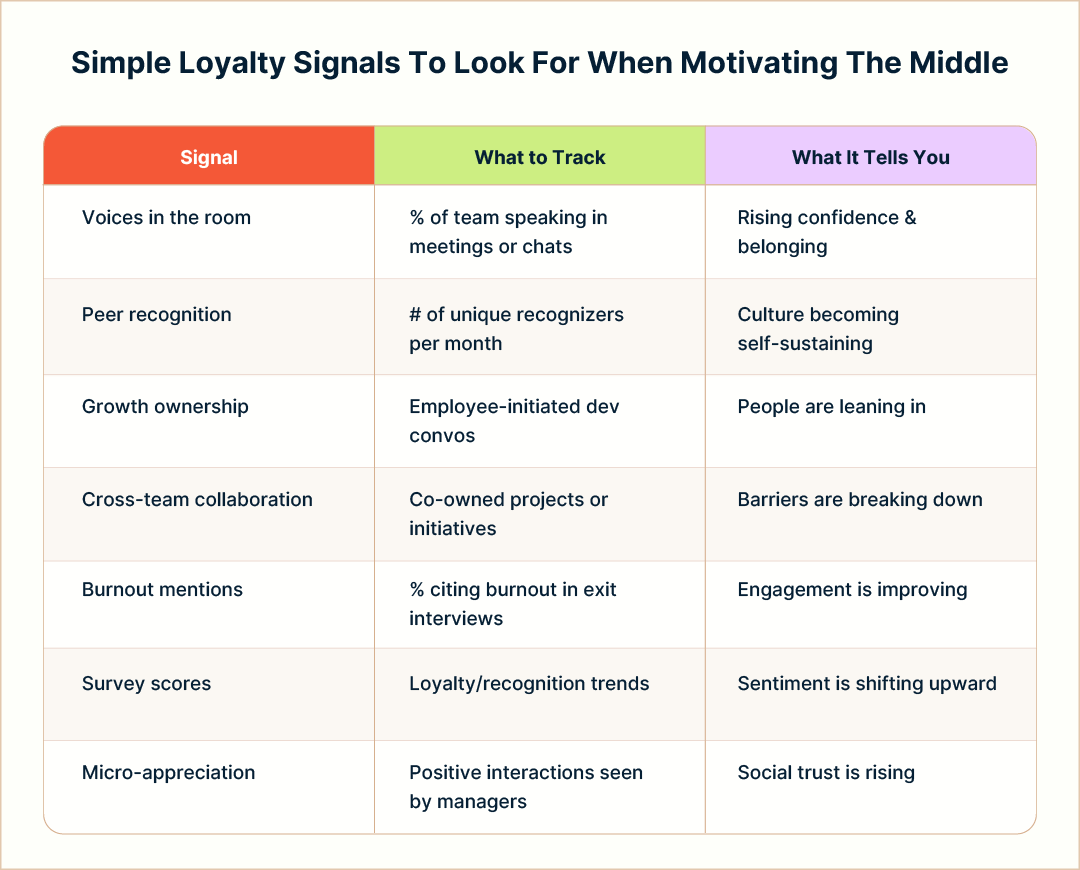
If You Want To Excel At Work, Engage The Middle
The to-do list of an HR professional is never-ending. There’s always a fire to put out or a policy to update, so much stuff gets put into the urgent pile. It’s easy to lose sight of the non-urgent tasks that can move the business and your role in it forward. The wavering middle doesn’t raise a red flag, but they do need attention. They make up nearly 50% of your organization, and they can’t be ignored.
Think of it this way: what would happen if one bad decision (or an outside factor) made half your wavering employees consider other options? How would that impact your work today? Would understaffing make your life harder? Would it drive away your top talent?
What would happen if you spent time on the wavering middle? Would your engagement scores increase? Would you see more employees stepping up for leadership roles? Could it impact your turnover numbers?
Wavering employees are worth the effort, and the action plan we've outlined provides a perfect roadmap for engaging these employees long-term.
Motivating the middle is only the start of your loyalty-building journey. Read our latest eBook, "The Loyalty Blueprint," for a step-by-step guide to showing loyalty to modern employees.
